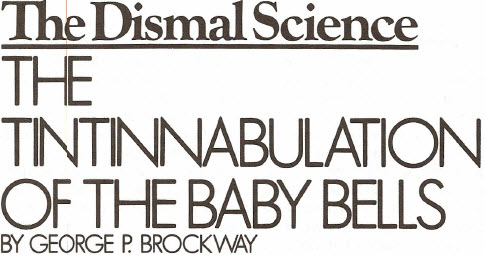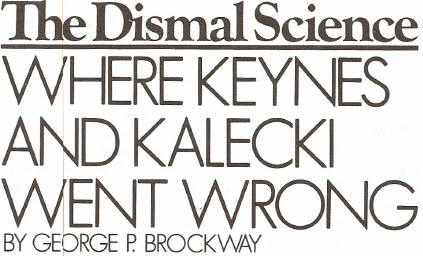By George P. Brockway, originally published July 15, 1991
IF YOU READ your morning paper thoroughly over the next several months you will read a lot of stories about the Baby Bells-the seven regional telephone companies that the courts split off from AT&T seven years ago. The stories will only occasionally make the front page, but buried in them will be accounting problems whose solutions are bound to have far-reaching social consequences.
Despite their popular name, the Baby Bells are all well up among the nation’s largest corporations and, as frequently happens with large corporations, they want to become larger. Their ambitions have been thwarted by the court order that created them; it forbids them to design, develop or manufacture telecommunications equipment. They are tempted by that forbidden fruit. At least one of them (the Pacific Telesis Group) is eager to turn pay phones into “information terminals, allowing customers to obtain and print out information on the spot.” No doubt you’ll dial a 900 number, which will charge your credit card a couple of dollars a minute and instruct you to “Press 1” if you want to know whether it’s raining, “Press 2” if you want the latest quotations on pork belly futures, and so on. As Stan Freberg would say, “Fright’nin’!”
Why has the fruit been forbidden? For the same reason that AT&T was broken up. Before 1984, the telephone system was a practically airtight monopoly. Although there were a few independents, almost everyone used equipment manufactured by Western Electric and owned, installed and serviced by AT&T. Like Henry Ford’s Model T, you could have any color you wanted as long as it was black. Now you can have a phone in every room or at the side of every chair, and no two need be of the same shape or color or come from the same source. But if the Baby Bells are allowed to manufacture phones, they’ll be able to diddle their costs in such a way that they will drive competitors off the market, and decorators will have to express our personalities for us in some other way.
I don’t mean to make light of the prospect, because far more than phone color is at stake. The issue-common to all business-turns on principles of cost accounting and (it is not too much to say) on the fundaments of economics itself.
You don’t have to read many of the debates in and out of Congress to realize that the Baby Bells want to expand into unregulated enterprises, of which the manufacture and sale of telephone equipment is one. Pacific Telesis wouldn’t be so eager to deploy an information network if it expected the system to be regulated. The Bells are no doubt averse to regulation in any circumstances (even if the fates of the S&Ls and the airlines should give them pause), but what mainly draws them to unregulated industries is the muddle headedness of conventional economics that would allow (or even require) them to charge the principal costs of their new unregulated businesses to their existing regulated telephone business. I’m sure you’ll be astonished to learn that the designated payers of these costs will be you, me, and other personal telephone subscribers.
Costs are important, and so are cost accountants. It used to be said of Macy’s (and perhaps of all department stores and many departmentalized businesses) that every department lost money but the store made money (it’s more likely vice versa today). Such a situation occurs when operating departments are charged too much for overhead, rent, taxes, or whatever.
But what is “too much”? The management of a department store may well feel helpless to control the different departments’ buying except by forcing them to become cost conscious. I once connived with the treasurer of a small company to confuse the president, whom we all admired and loved, by introducing a large entry for “late bills prior season” in the advertising budget, thus eliminating any reserve. The exuberant president couldn’t spend what apparently didn’t exist, and the company survived some hard times.
Every business makes not-dissimilar decisions constantly. If a company expands, management takes profits earned by this year’s operations and invests them in new products or new divisions. Or management may price a certain product more tightly or advertise it more generously than it does other products. The favoritism may be explained by expectations of increasing returns or by use of the underpriced product as a loss leader or by pursuit of the prestige attached to prominence in a certain business – or by flipping a coin. Regardless of the explanation, the favoritism is a business decision. It shapes the corporation.
Public utilities, naturally, are not quite free enterprise. The investors in a public utility are free to do what they want with their money. They can leave it in or take it out (they hope). The workers are free to do what they want with their labor power: They can stay on their jobs (if they are not made obsolete by technology) or leave them. But the management cannot set prices-at least not without regulators looking over their shoulders -and when prices are regulated, costs and their allocation must be regulated, too.
Neither managers nor regulators have much of a problem with costs so long as the utility is merely a utility and does not long to embark on an ambitious expansion program. There may be a little scuffle over whether certain costs should be capitalized rather than expensed, but “generally recognized accounting principles” will take care of most such questions. When, however, a local phone company wants to shift from copper wire to fiber optics, the cost is hard to justify-unless management intends to expand into cable television or computer networking or some other wave of its future. Alert regulators will not let the cost of fiber optics become part of the cost of local telephone service, and the local phone company will complain that regulation impedes progress.
Moreover, the utility’s lawyers, tutored by their economics experts, will adduce what they call scientific reasons for charging the new costs to the old users. There are several ways of doing this. One is called Ramsey Pricing, a.k.a. the Inverse Elasticity Rule (elasticity is a big idea in economics, but I’m not inclined to take it seriously, for reasons I may someday explain). Another is Marginal Cost Pricing.
It is not my present purpose to examine the two strategies in detail, especially since I can refer you to two excellent articles that do so in the March 1991 Journal of Economic Issues–the first by Michael Sheehan, an Oregon public utility economist, and the second by Peter S. Fisher, an associate professor of urban and regional planning at the University of Iowa. In a nutshell, both articles demonstrate that, as Fisher writes, “There is a systematic bias” to these pricing policies “in favor of those who are more mobile, who have more income, and hence have more choices regarding consumption, and against those whose income or social position leaves them with fewer alternatives and with large portions of their incomes going to basic goods and services.”
IS SCIENCE, then, anti-people? No, and it’s not pro-progress, either. Science has nothing to do with the case. The various pricing policies obviously concern values. But, as Max Planck wrote, “The values of an objective science like physics are wholly independent of the objects to which they relate.” In other words, electrons know no value, but accuracy in physics reports has great personal and social value. In contrast to electrons, the prices set by Ramsey Pricing are social values.
The whole idea of scientific or objective pricing in economics is a confusion of thought. Science can’t be regulated as industry can. No matter how forceful your argument, you can’t change E =MC2 to E= MC3, or some other exponent more to your liking. But utility rates are not written in the book of nature; they are regulated by public commissioners in accordance with guidelines laid down by the legislature and subject to review by the courts.
The regulations represent the public will, deliberately supplanting the will of the utility companies. If the regulations didn’t have such force, there would be no point to them. Likewise, if the uncontrolled will of the utilities were not thought liable to produce rates that would in some manner be unfair to some segments of society; there would be no point to the regulations.
Conventional economics, of course, maintains that all rates and prices are or should be set by the market, and we are so used to the idea that we nod in unthinking assent. It is hardly clear, though, how a market sets a price. A market can’t talk or write or make gestures or pass resolutions or do anything. How can it set a price? The conventional story is a pathetic fallacy.
Prices are set by human beings or by corporations of human beings. That is reasonable, but there is nothing scientific about any of it. If there were, there would be no failures-and no smash successes. When you mix the proper proportions of hydrogen and oxygen, you get water. Every time. But a 50 per cent markup doesn’t guarantee a retailing success, nor did strong popular interest in a new mid-price car guarantee the success of the Edsel.
There is no one way to determine prices, nor do any of the possible ways have invariable consequences. Furthermore, price plays an original role in business planning. The Edsel was planned from the beginning to be a mid-priced car. With the price given, engineers and designers and marketing people had goals to work toward. As it turned out, fatal mistakes were made, but without the price, their endeavors would have been altogether without form and void.
Price, in short, is not determined; it is determining. That is the way it is in business, with the possible exception of some agriculture, occasional auctions and the stock exchanges. Setting the price (which may be done by buyer or middleman as well as by seller) is an act of will. It is a free and responsible act. It is at the very heart of free enterprise. In private business, setting the price is a determinant of the kind of business we will have, of the kind of people we will be. In the case of public utilities, setting the price is a determinant of the kind of society we will have.
When a private company fails because its prices are too high (or too low), it doesn’t get a gold star for having set the prices in some conventional pseudoscientific fashion. Nor does a regulatory commission get Brownie points for following pseudoscientific Ramsey Pricing if the result is to foster another way of finding out whether it’s raining by rendering ordinary telephone service too expensive for its most needy subscribers.
The New Leader


